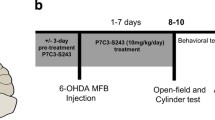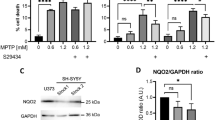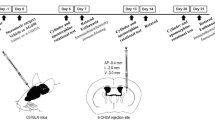Abstract.
The propargylamine derivative CGP 3466 (dibenzo[b,f]oxepin-10-ylmethyl-methyl-prop-2-ynyl-amine) has previously been found to exhibit neurorescuing and antiapoptotic properties in several in vitro and in vivo paradigms. After showing that this compound does not inhibit monoamine oxidase B and only marginally inhibits monoamine oxidase A at concentrations or doses far above those relevant for its reported neuroprotective effects, we investigated it in models considered relevant for Parkinson's disease. CGP 3466 or its hydrogen maleate salt, CGP 3466B, at concentrations between 10–11 M and 10–7 M, protected rat embryonic mesencephalic dopaminergic neurons in free-floating or dispersed cell culture from death inflicted by treatment with 1-methyl-4-phenyl pyridinium ion (MPP+) as measured by different readouts such as dopamine uptake, tyrosine hydroxylase activity, and counts of tyrosine hydroxylase-positive cells. Treatment of mice lesioned with 1-methyl-4-phenyl-1,2,3,6-tetrahydropyridine (MPTP; 2×30 mg/kg s.c. at a 72-h interval) with CGP 3466 (0.1 mg/kg s.c.) or CGP 3466B (0.014 mg/kg and 0.14 mg/kg p.o.) b.i.d. for 18 days partially prevented the loss of tyrosine hydroxylase-positive cells in the substantia nigra; a lower dose of CGP 3466B (0.0014 mg/kg p.o.) showed a marginal effect, whereas a high dose, i.e. 1.4 mg/kg p.o., was ineffective, suggesting a bell-shaped dose-response relationship which has also been observed in other paradigms.
The effect of CGP 3466 on motor function was evaluated in rats that received intrastriatal injections of 6-OHDA unilaterally, according to a four-site injection protocol, and that were subsequently treated b.i.d. with 0.014 mg/kg i.p. CGP 3466B for 3 weeks. After another 3 weeks without treatment, skilled paw use was assessed by means of the staircase test. The results indicated a significant improvement of skilled motor performance as measured by means of the number of eaten pellets. Since due to the long washout period a symptomatic effect of CGP 3466B can be ruled out, it is likely that this improvement was related to interference with the course of the degeneration of the dopaminergic neurons.
In conclusion, our results indicate that CGP 3466 is able to prevent death of dopaminergic cells in in vitro and in vivo models of Parkinson's disease. In addition, treatment with CGP 3466 resulted in improved skilled motor performance in 6-OHDA-lesioned rats.
Similar content being viewed by others
Author information
Authors and Affiliations
Additional information
Electronic Publication
Rights and permissions
About this article
Cite this article
Waldmeier, P., Spooren, W. & Hengerer, B. CGP 3466 protects dopaminergic neurons in lesion models of Parkinson's disease. Naunyn-Schmied Arch Pharmacol 362, 526–537 (2000). https://doi.org/10.1007/s002100000300
Received:
Accepted:
Issue Date:
DOI: https://doi.org/10.1007/s002100000300




